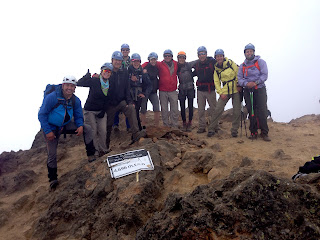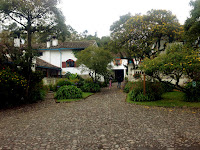Volcanoes of Ecuador
(double click to enlarge pictures)
At 17,600' the situation started to change quickly, we were roped together on a precarious ice ridge during the predawn darkness on the iconic Cotopaxi volcano. When Loraine appeared to be suffering from severe altitude sickness...
At 17,600' the situation started to change quickly, we were roped together on a precarious ice ridge during the predawn darkness on the iconic Cotopaxi volcano. When Loraine appeared to be suffering from severe altitude sickness...
 |
| OSVALDO, JOAQUIN GUIDES-MELODY, ADRIANA,ANDREA, KALE, GABBY, MARGARET, LORAINE AND CHRISTINA |
We had joined Wally Berg of Berg Adventures for another exciting journey along the "Avenue of the Volcanoes" outside of Quito, Ecuador. Several of my friends from the 2016 Mt Elbrus Russia trek had joined us. Kale, Melody, Christina and her husband Stephan, Kale brought his climbing partner Gabby, plus we had our two new Brazilian friends-Adriana and Andrea, and Margaret from Australia.
 |
| EQUATOR |
Ecuador is right on the equator
with 370
volcanoes and 68 of them are still active. This makes for some of the most unique and challenging climbing in the world.
 |
| CO-CAPTAIN KALE AND LORAINE RUCU PEAK LOOMS BEHIND |
 |
| 200' SCRAMBLE STRAIGHT UP |
 |
| FORGING AHEAD |
 |
| TOP OF RUCU PICHINCHA -15,500' |
 |
| HELEFERIA CARIBA CAFE ICE CREAM SHOP |
The next day we headed to the Hacienda Monastery Cusin, built in 1857. What a place! the common areas had fireplaces, sitting rooms and a library. The entire grounds were manicured with a lush tropical garden theme.
 |
| STUNNING GARDENS |
 |
| ENTRANCE TO HACIENDA CUSIN |
 |
| GUINEA PIG LAKE |
Our guide shared his story about "San Pedro (hallucinogenic drug), that is similar to Ayahuasca,
(like LSD or Peyote). He explained... "I saw the night sky crack open." This vision gave him enlightenment and it changed his life. He gave up the craziness of a successful fast paced career and took up guiding.
(like LSD or Peyote). He explained... "I saw the night sky crack open." This vision gave him enlightenment and it changed his life. He gave up the craziness of a successful fast paced career and took up guiding.
So I asked him if he had
 |
| LITTLE ILLEGAL CROSSING |
Fuya Fuya...volcano #2) 12,990’, as the saying goes.. Fuya once shame on you, Fuya twice shame on me...but no Fuya 3 times😃


 |
| TOP OF FUYA FUYA |
 |
| CHRISTINA'S HEAD STAND |
 |
| ROCK CLIMBING ON ROPES |
 |
| COURT YARD AT GUACHALA WITH CHURCH IN BACKGROUND |
Some of the granted land became places of commerce for selling various wares of the local native people, and some had forced labor. They all have large courtyards, with lots of rooms and usually a church. The owner of Guachala Hacienda is Diego. He inherited it from his diplomatic father and was raised in Europe, and even went to the US and attended Stanford for his master's degree. He returned to Ecuador and became mayor of the local city and helped the town rebuild 300 homes after the 1987 earthquake.
 |
| NATIVE BABIES WRAPPED IN CLOTH AND PUT IN THE RAFTERS |
One of the cool features of the Hacienda's is the rooms had their own fireplace that the staff would light every night. The Guachala Hacienda had a fascinating church, this one was a little different. In the early years when the local native babies died, and had not been baptized, they were wrapped in a cloth and placed up in the rafters to be closer to heaven.
 |
| COTOPAXI 19,350' |
 |
| DOUBLE CLICK & FIND THE JOSE RIVAS HUT IN THE MIDDLE AT 14,750' |
 |
| TREK UP TO THE TOP OF COTOPAXI 19,350' (5,900m) |
 |
| STEEP!! ICE AXE IN HAND |
 |
| INDENTED TRAIL ON THE LEFT |
 |
| LIKE WALKING ON CLOUDS |
In the meantime our four stars were making their way to the top: Kale, Gabby, Christina and Stephen. Exhausted at nearly 19,000' Stephen had to drop off Christina's line, and joined Kale and Gabby as they headed down from the summit. Christina charged her way to the top of the summit with Joaquin to 19,350'.
 |
| HOT SPRINGS OUTSIDE THE CABINS |
 |
| LIFE IS GOOD |
 SPA BREAK: After Cotopaxi we drove to the luxurious spa at Termas Papallacta, at 11,000'. The spa was surrounded with magical tropical gardens and the thermal pools intertwined between the cabins. Time for a Swedish massage! and a few of the women did wine body wraps, and my favorite was the chocolate wrap (you were wrapped up tight like a sardine and blindfolded so nobody really felt relaxed).
SPA BREAK: After Cotopaxi we drove to the luxurious spa at Termas Papallacta, at 11,000'. The spa was surrounded with magical tropical gardens and the thermal pools intertwined between the cabins. Time for a Swedish massage! and a few of the women did wine body wraps, and my favorite was the chocolate wrap (you were wrapped up tight like a sardine and blindfolded so nobody really felt relaxed).
CHIMBORAZO (volcano #4) 20,700’ (6,300m).
By this point most of the team had met their threshold and they were finished with climbing. The Chimborazo volcano was looming, the highest elevation point from the center of the earth --can you figure that one out? Loraine and I decided to take a day hike from the lodge at 13,124' (we hiked up 1,200' to the base of the volcano) and waited for a cloud break to see the whole face of the volcano reveal itself, but it never happened.
In the meantime Kale, Gabby, Adriana and Andrea attempted the climb to the summit. They had a challenging time and made it up to 18,600’ before the altitude worsened Gabby’s cold condition and the dry heaves were kicking in. On the return trip down it was still dark, Juan their guide suddenly fell off the trail! Turns out, he was dodging a falling rock. In this area there used to be sufficient glacial ice to hold the rocks in their position, but nowadays due to the warming climate; the rock falls are more frequent and dangerous. Thank goodness everyone made it back safely.
ESTRELLA DEL CHIMBORAZO LODGE
 |
| CHIMBORAZO VOLCANO 20,700' (6,300M) OCTOBER 2018 |
ESTRELLA DEL CHIMBORAZO LODGE
 |
| ESTRELLA LODGE IN FRONT CHIMBORAZO |
 |
| OLD PICTURES AND CLIMBING GEAR-BACK IN THE DAY |
 We were able to meet Marco Cruz, the famous mountain climber
We were able to meet Marco Cruz, the famous mountain climber (and guide) who first ascended Chimborazo as a boy at the age of 13. He is the owner of the Estrellla Del Chimborazo Lodge where where we stayed. The main lodge is rustic, warm and cozy. It is enriched with a fascinating collection of famous mountaineer pictures and some of the first mountaineering equipment ever used; it was like walking through a really cool museum. Each of the rooms were named after a famous mountain climber; we were in the Walter Bonatti room.
CLIMATE CHANGE: It would be nice not to have to write about this topic on one of my trips, but here it was again in full force and with our guide's life experiences of climbing these areas verifying previous glacial coverage.
 |
| CHIMBORAZO VOLCANO HANGING GLACIER 1960s - |
Joaquin our Ecuadorian guide said, "that in the last 50-60 years the glaciers in in Ecuador had receded an average of 300', and 50% of that was in the last 15 years!" Marco Cruz took me over to the wall in his lodge and showed me pictures taken of Chimborazo in the 1960s. He compared his photos (past and present) indicating that the hanging glacier of the Chimborazo volcano has lost 50% of its depth (he estimated it to be close to 150').
 |
| OLD CLIMBING ROUTES UP THE FACE OF CHIMBORAZO VOLCANO - PRE 1960s |
 |
| 2018 HANGING GLACIER PRESENT DAY |
 |
| MARCH 23, 1986-FEB. 5TH-2012 |
CONCLUSION: This was absolutely and incredible trip with excellent guides. Our limits were pushed physically and mentally, we returned home healthy, enriched, humbled, and once again reminded that we live on a very fragile planet and we can't let apathy creep in and do nothing for our wonderful home.
SUGGESTIONS: 1. Berg Adventures International: 5 stars
2. Stay at the Marriott in Quito--be spoiled-waterfall pool.
3. Ask guide what you expect to be achieved during breaks.
4. Take Diamox- 125 mg morning and night.
5. Take a trip to the Amazon while you are there.
6. The Ahi sauce is a cultural experience in all the restaurants.





No comments:
Post a Comment